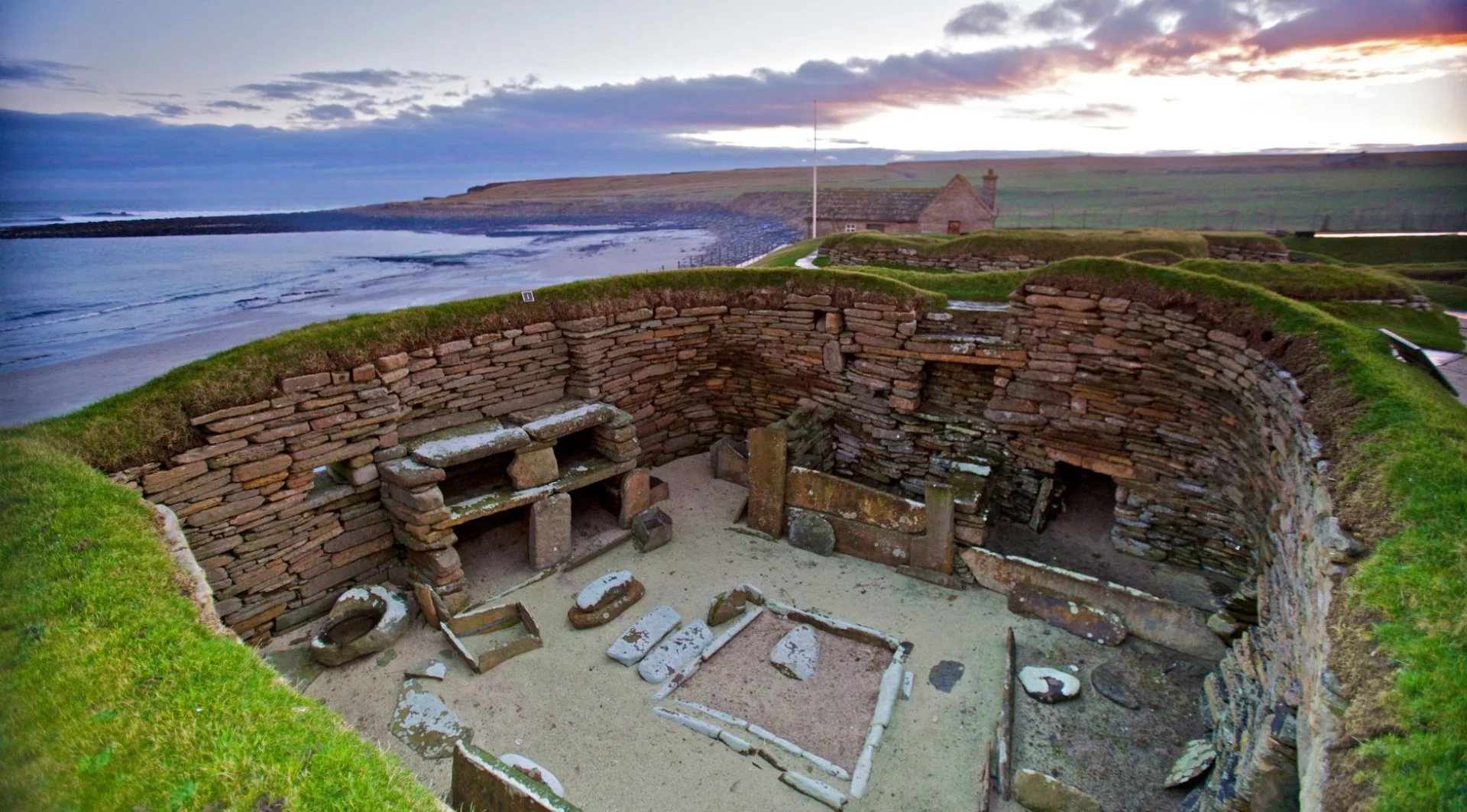
The Ancient Village of Skara Brae
In 1850, a powerful storm in the Orkney Islands exposed the buried remains of an ancient village, later named Skara Brae. Unlike many ancient sites, it was remarkably well-preserved, earning comparisons to Pompeii. But instead of being buried by catastrophe, Skara Brae was gradually covered by sand, keeping its stone structures intact for over 5,000 years.
Dating back to around 3,180 BCE, Skara Brae is older than the Great Pyramids of Egypt. The village consisted of stone houses with built-in furniture, central hearths, and even an early drainage system. The homes were connected by covered passageways, providing shelter from Orkney’s harsh weather. Archaeologists estimate that 50 to 100 people lived there, forming a structured, close-knit community.
Skara Brae’s discovery reshaped our understanding of Neolithic life, revealing a society that was far more advanced than previously thought. Today, it is part of the “Heart of Neolithic Orkney,” a UNESCO World Heritage site, and remains one of the most significant prehistoric settlements in Europe.
Neolithic Orkney
Five thousand years ago, Orkney was a very different place from what it is today. The islands, located off the northern coast of Scotland, were warmer and more fertile than they are now, making them ideal for early farming communities. Dense forests of birch, hazel, and willow covered parts of the landscape, providing timber for fuel and construction. The surrounding seas were rich in fish and shellfish, and the coastline teemed with seals and seabirds, offering a steady source of food. The land was well-suited for growing barley, the staple crop of Neolithic Scotland, and for grazing domesticated animals like cattle and sheep.
Orkney’s location made it a prime settlement area during the Neolithic period. Positioned between Scotland and Scandinavia, the islands may have been a center for trade and cultural exchange. The people of Skara Brae and other nearby settlements were not isolated; evidence suggests they had contact with other Neolithic communities across the British Isles. Archaeological finds, such as carved stone balls similar to those found in mainland Scotland, hint at shared traditions and technological knowledge.
Despite its natural advantages, life on Orkney was shaped by its exposure to the elements. The North Atlantic brought strong winds and frequent storms, requiring robust construction techniques. This likely influenced the decision to build homes from stone rather than timber, as trees became scarce over time. The sea provided transport routes but also posed dangers, with rising tides and shifting coastlines potentially threatening settlements. Skara Brae itself may have been abandoned due to environmental changes, as erosion and rising sea levels slowly reshaped the landscape.
Early Excavations
In 1850, a powerful storm swept across Orkney, stripping away layers of sand and earth to reveal the ruins of an ancient village. William Watt, the local landowner and an amateur antiquarian, took an immediate interest in the site. Recognizing its historical significance, he began excavations, though his methods were rudimentary by modern standards. His work uncovered several stone houses filled with artifacts, but without proper recording techniques, some early discoveries were lost or misinterpreted.
At first, archaeologists assumed Skara Brae was from the Viking Age, as no one expected such a well-preserved settlement to be thousands of years older. It wasn’t until radiocarbon dating became available in the mid-20th century that the true age of the village was confirmed, placing it in the late Neolithic period around 3,180–2,500 BCE. This revelation reshaped perceptions of prehistoric Britain, proving that sophisticated settlements existed long before the construction of Stonehenge.
More systematic excavations took place in the 1920s and 1970s, led by archaeologists such as Gordon Childe and later teams using modern techniques. These digs provided crucial insights into daily life at Skara Brae, uncovering tools, pottery, and even small carvings that may have had religious or cultural significance. Advances in technology have since allowed researchers to analyze microscopic plant remains, animal bones, and DNA traces, further refining our understanding of the people who lived there.
Today, Skara Brae remains one of the most important Neolithic sites in Europe. Ongoing research continues to uncover new details, with modern imaging techniques and environmental studies helping archaeologists piece together the lives of its long-gone inhabitants.
The Architecture and Design of Skara Brae
Skara Brae’s design reflects both the ingenuity and resilience of its Neolithic builders. The village was constructed to withstand Orkney’s harsh climate, with structures built into midden—a mixture of refuse and sand—that acted as natural insulation against the wind and cold. The dwellings were partly sunken into the earth, reducing exposure to the elements while maintaining stability against powerful Atlantic storms. Unlike many prehistoric settlements that relied on timber, Skara Brae’s buildings were made entirely of locally sourced flagstone, a material abundant on Orkney’s shores.
Each house followed a remarkably similar layout, suggesting a standardized approach to domestic architecture. Inside, the rooms were centered around a hearth, which provided warmth and light. Stone furniture, including beds, shelves, and dressers, was built directly into the walls, maximizing space and ensuring durability. The beds were lined with soft materials such as heather and animal skins for insulation. Some houses contained small stone boxes, believed to be storage containers for food or personal belongings.
The passageways connecting the houses were a key feature of the village’s design. These low, covered corridors allowed residents to move between homes without being fully exposed to the elements. Some sections of the passageways could be closed off with stone slabs, providing privacy and protection. This network of walkways suggests a cooperative community where movement and interaction were carefully managed. Additionally, some dwellings had small side chambers, possibly used for food storage or as workspaces, indicating an understanding of household organization and resource management.
Daily Life in Skara Brae
Life in Skara Brae revolved around survival, community, and daily rituals that were likely passed down through generations. The villagers were skilled farmers, hunters, and fishermen, relying on a combination of cultivated and foraged foods. Their diet included barley, wild plants, and berries, supplemented by domesticated cattle, sheep, and pigs. The surrounding waters provided an abundance of shellfish, fish, and even the occasional whale carcass. Evidence of grinding stones suggests that grains were processed into flour, possibly for baking unleavened bread or porridge. Meat and fish were likely smoked or dried for preservation, ensuring food supplies during the harsh winters.
The tools and household items found at Skara Brae reveal a society that was both practical and resourceful. Flint and bone were used to craft knives, scrapers, and fishing hooks, while polished stone tools suggest advanced woodworking and butchering techniques. Decorative artifacts, such as carved stone balls and small ivory beads, indicate that personal adornment was important. Some items may have held symbolic or spiritual significance, hinting at a belief system within the community.
Clothing would have been made from animal hides, woven plant fibers, and possibly wool, though textiles rarely survive in the archaeological record. Bone needles suggest that garments were sewn together, and some beads and pins may have been used for decoration or fastening clothing. Given the cold climate, layered clothing was likely essential, and fur-lined garments could have provided additional warmth.
Social structure in Skara Brae remains a topic of debate, but the uniformity of the houses suggests a relatively egalitarian society. Unlike later settlements where status differences were marked by larger or more elaborate dwellings, the homes in Skara Brae were of similar size and design. This suggests that resources were shared, and no single family or individual held significantly more power than others. The close proximity of the homes, along with shared passageways, indicates a strong communal bond, with cooperation playing a central role in daily life.
Though the specifics of their spiritual beliefs remain unknown, the presence of decorative carvings and carefully placed objects suggests that rituals or ceremonies were part of life at Skara Brae. Some archaeologists speculate that the hearths at the center of each home were not just for cooking but also for symbolic purposes, possibly serving as focal points for family gatherings or spiritual practices. Whatever their beliefs, the people of Skara Brae left behind a legacy of resilience and ingenuity, adapting to their environment in ways that still fascinate researchers today.
Advanced Features of Skara Brae
Skara Brae’s inhabitants engineered a rudimentary but effective drainage system, one of the earliest known examples of waste management in prehistoric Europe. Small channels were carved into the village floor, directing water and waste away from living spaces. Some houses even contained what appear to be stone-built toilet areas, suggesting a communal effort to maintain hygiene. This level of sanitation was rare for Neolithic settlements, highlighting the villagers’ ability to adapt to their environment.
Storage was a crucial aspect of life in Skara Brae, as food preservation was necessary for survival through harsh winters. Stone boxes, or “tank-like” compartments, have been found inside houses, possibly used to store shellfish or other perishable goods. These containers may have been lined with seaweed or cold water to keep contents fresh. The presence of grinding stones and querns suggests that grains were processed within homes, indicating an efficient system for food preparation and storage.
Carved stones found throughout the site suggest that Skara Brae’s people valued symbolism and artistic expression. Some stones feature intricate patterns, including spiral and lozenge shapes, similar to those seen at other Neolithic sites like Newgrange in Ireland. These carvings may have had religious or cultural significance, possibly representing seasonal cycles, family lineage, or spiritual beliefs. The lack of written records makes interpretation difficult, but these designs provide a rare glimpse into the mindset of a long-lost community.
Theories on Why It Was Abandoned
One prevailing theory is that climate change played a role in Skara Brae’s abandonment. Around 2,500 BCE, evidence suggests that Orkney’s climate became colder and wetter, making farming increasingly difficult. Rising sea levels and coastal erosion may have further threatened the settlement, gradually encroaching on the village and forcing its residents to relocate inland. The shifting coastline is still a threat to the site today, with ongoing preservation efforts needed to prevent further damage.
Resource scarcity or social conflicts may have also contributed to the village’s decline. If food supplies became unreliable due to poor harvests or overfishing, tensions could have risen among the inhabitants. Some scholars suggest that competition for resources, or even external threats from other communities, may have driven people away. However, no evidence of warfare or violent destruction has been found, making this theory speculative.
Unlike catastrophic abandonments seen at other prehistoric sites, Skara Brae appears to have been left behind gradually. Archaeological evidence does not suggest a sudden disaster, such as a flood or invasion, but rather a slow migration away from the site. Artifacts like tools and household items were not left in a way that indicates a hurried departure, implying that the villagers had time to pack their belongings and move elsewhere. Whether due to environmental pressures, resource depletion, or changing social structures, the reasons behind Skara Brae’s abandonment remain one of its greatest mysteries.
Skara Brae in Context With Other Neolithic Sites
Skara Brae is not unique in Neolithic Europe, but its level of preservation sets it apart. Similar stone-built villages have been found in the British Isles, such as Barnhouse and Rinyo in Orkney, and Links of Noltland on the nearby island of Westray. These sites share common features like subterranean houses, central hearths, and passageways, suggesting a regional architectural tradition. On the European mainland, sites like Çatalhöyük in Turkey, though much older (c. 7,500 BCE), also show signs of early communal living with standardized house layouts and shared spaces. However, Skara Brae’s well-preserved furniture and intricate passage system make it a rare window into daily life.
Skara Brae was part of a much larger Neolithic landscape in Orkney. The islands are home to an extensive network of megalithic sites, including the Ness of Brodgar, a massive ceremonial complex that may have been a central gathering place for Neolithic communities. The proximity of Skara Brae to these monuments suggests its inhabitants were connected to wider religious or social practices. The settlement likely participated in shared rituals, trade, and cultural exchanges with other communities in Orkney and beyond.
Orkney’s standing stones and chambered tombs indicate a sophisticated society with strong spiritual traditions. The Ring of Brodgar, a massive stone circle, and the Stones of Stenness, one of the oldest henge monuments in Britain, suggest a deep understanding of astronomy and seasonal cycles. The chambered tomb of Maeshowe, aligned with the winter solstice, reflects the same architectural precision seen in Skara Brae’s homes. The alignment of these structures hints at a civilization that carefully planned its settlements in relation to celestial events, reinforcing the idea that Skara Brae was part of a broader Neolithic culture that valued both practical living and spiritual expression.
Skara Brae’s Place in Modern Archaeology
Skara Brae’s discovery revolutionized the study of Neolithic Britain, and its preservation remains a priority. Coastal erosion continues to threaten the site, with rising sea levels and stronger storms placing it at risk of destruction. Efforts by Historic Environment Scotland and UNESCO have led to protective measures, including reinforced seawalls and digital mapping to document the site in case of future loss. The debate over relocating or further excavating parts of the settlement remains ongoing, as any disturbance risks damaging fragile structures.
Advances in archaeological technology have provided new insights into Skara Brae. Microscopic analysis of plant remains has revealed details about the villagers’ diet, while isotopic studies of human bones are helping to determine their origins and health. Ground-penetrating radar has uncovered evidence of additional structures buried beneath the site, suggesting that Skara Brae may have been larger than previously thought. DNA analysis of animal bones could also shed light on domestication practices and potential trade connections with other Neolithic communities.
Despite its extensive study, Skara Brae remains shrouded in mystery. Some theories propose it was more than just a village, possibly serving as a seasonal gathering place or a site of ritual significance. Myths and speculation have added to its intrigue, with some claiming links to lost civilizations or even Atlantis, though these ideas lack scientific basis. The absence of weapons and defensive structures has led to speculation about Skara Brae being an unusually peaceful society, though it is impossible to confirm. While much has been uncovered, Skara Brae continues to challenge historians and archaeologists, offering new questions as much as answers about the people who once called it home.
Visiting Skara Brae Today
Skara Brae is one of Scotland’s most visited prehistoric sites, offering tourists an unparalleled glimpse into Neolithic life. Located on the western coast of Mainland Orkney, near the Bay of Skaill, the site features a cluster of well-preserved stone houses that visitors can explore from designated pathways. A modern visitor center provides exhibits showcasing artifacts recovered from the village, including tools, pottery, and decorative items. A reconstructed house outside the site allows visitors to step inside and experience what a Neolithic home may have felt like, complete with stone furniture and a central hearth.
Walking through Skara Brae, visitors can see details that bring the past to life—stone dressers still standing where they once held household items, passageways worn smooth by generations of footsteps, and carved markings whose meanings remain unknown. The surrounding landscape, though changed over millennia, gives a sense of the isolation and beauty that must have shaped daily life for its ancient inhabitants. Interpretive signs and guided tours provide historical context, explaining how the village functioned and the challenges its people faced.
Preserving Skara Brae is an ongoing effort, as coastal erosion threatens to reclaim the site. A protective seawall has been installed to slow the effects of encroaching tides, but long-term solutions remain a challenge. Conservationists continuously monitor the structures, using non-invasive techniques to assess stability and prevent further deterioration. Due to its fragile state, visitors must stay on designated paths to prevent unnecessary wear on the stonework. Historic Environment Scotland, which manages the site, conducts regular maintenance to ensure that Skara Brae remains accessible to future generations.
As part of the Heart of Neolithic Orkney, Skara Brae is a UNESCO World Heritage site, recognized for its outstanding historical and cultural significance. UNESCO’s designation has helped secure funding for research, conservation, and educational programs. Along with nearby sites like Maeshowe and the Ring of Brodgar, Skara Brae plays a central role in understanding Neolithic Britain. International collaboration continues to support its preservation, ensuring that this extraordinary glimpse into prehistoric life remains protected against time and the elements.
Photo Credit : orkney.com : The official Orkney’s tourism Website
Historic Environment Scotland – https://www.historicenvironment.scot
UNESCO World Heritage Centre – https://whc.unesco.org/en/list/514
BBC History – Skara Brae – https://www.bbc.co.uk/history/ancient/british_prehistory/
National Museums Scotland – https://www.nms.ac.uk
British Museum – Prehistoric Britain – https://www.britishmuseum.org
The Archaeology Data Service (ADS) – https://archaeologydataservice.ac.uk
The University of the Highlands and Islands Archaeology Institute – https://www.uhi.ac.uk/en/research-enterprise/
Canmore (National Record of the Historic Environment, Scotland) – https://canmore.org.uk/site/
Current Archaeology Magazine – https://www.archaeology.co.uk



